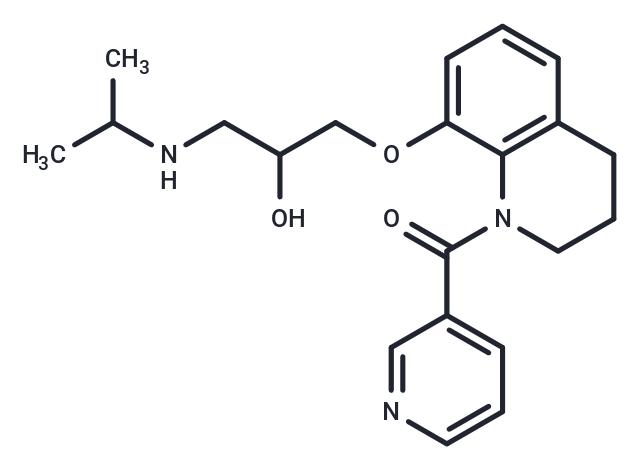Shopping Cart
Remove All Your shopping cart is currently empty
Your shopping cart is currently empty
Nicainoprol (RU-42924) is a fast-sodium-channel blocking drug. Nicainoprol is a potent antiarrhythmic agent.

| Pack Size | Price | USA Warehouse | Global Warehouse | Quantity |
|---|---|---|---|---|
| 1 mg | $143 | In Stock | In Stock | |
| 5 mg | $363 | In Stock | In Stock | |
| 10 mg | $538 | In Stock | In Stock | |
| 25 mg | $855 | In Stock | In Stock | |
| 50 mg | $1,150 | In Stock | In Stock | |
| 100 mg | $1,550 | - | In Stock | |
| 1 mL x 10 mM (in DMSO) | $369 | In Stock | In Stock |
| Description | Nicainoprol (RU-42924) is a fast-sodium-channel blocking drug. Nicainoprol is a potent antiarrhythmic agent. |
| In vitro | The antiarrhythmic agent Nicainoprol is a fast-sodium-channel blocking drug that also protects isolated rat hearts against reperfusion arrhythmias. However, it is without beneficial effects on cardiac hemodynamics and biochemical parameters, in contrast to the ACE inhibitor[1]. |
| In vivo | The study investigates the efficacy of Nicainoprol, a novel antiarrhythmic agent, in mitigating coronary occlusion and reperfusion arrhythmias in both isolated working rat hearts and anesthetized rats. In isolated hearts, Nicainoprol demonstrates a concentration-dependent protective effect against reperfusion arrhythmia without altering cardiodynamics, except for a decrease in heart rate at the highest tested concentration (100 μM). Key cardiac biochemical markers (lactate dehydrogenase and creatine kinase) and metabolite levels (glycogen, lactate, ATP, and creatine phosphate) remain unchanged by Nicainoprol treatment. In anesthetized rats, Nicainoprol administration (5 and 10 mg/kg, i.v.) significantly diminishes the incidence of premature ventricular complexes and ventricular tachycardia during the early post-occlusion phase (0-30 minutes), and entirely prevents ventricular fibrillation. During reperfusion, Nicainoprol-treated rats show a marked reduction in premature ventricular complexes compared to control rats, alongside reductions in heart rate, blood pressure, and myocardial oxygen consumption. Furthermore, Nicainoprol significantly decreases the ratio of infarct mass to ventricular mass by 20% and 28% at doses of 5 mg/kg and 10 mg/kg, respectively, indicating potential benefits in preventing and treating arrhythmias associated with acute myocardial infarction. |
| Synonyms | RU-42924 |
| Molecular Weight | 369.46 |
| Formula | C21H27N3O3 |
| Cas No. | 76252-06-7 |
| Smiles | CC(C)NCC(O)COc1cccc2CCCN(C(=O)c3cccnc3)c12 |
| Relative Density. | 1.187g/cm3 |
| Color | White |
| Appearance | Solid |
| Storage | Powder: -20°C for 3 years | In solvent: -80°C for 1 year | Shipping with blue ice/Shipping at ambient temperature. | |||||||||||||||||||||||||||||||||||
| Solubility Information | DMSO: 55 mg/mL (148.87 mM), Sonication is recommended. | |||||||||||||||||||||||||||||||||||
Solution Preparation Table | ||||||||||||||||||||||||||||||||||||
DMSO
| ||||||||||||||||||||||||||||||||||||
| Size | Quantity | Unit Price | Amount | Operation |
|---|

Copyright © 2015-2025 TargetMol Chemicals Inc. All Rights Reserved.